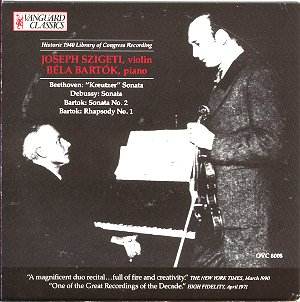One of a number of remarkably preserved concerts at
the Library of Congress this recital is one of the most distinguished
and important of CDs. It contains the entire recital of 13th
April 1940 given by Szigeti and Bartók under the auspices of
the Elizabeth Sprague Coolidge Festival. If our understanding and knowledge
of Szigeti’s art is not radically altered nevertheless the musico-aesthetic
complexities of his partnership with Bartók are rich and the
light it shines on Bartók’s pianism is fundamental. The two musicians
had given recitals together since the mid-1920s – in Budapest, Berlin,
London, Oxford, Paris, Rome and New York. Both had recently emigrated
to America – though Bartók was to make one final trip home –
and were central members of the Hungarian intellectual diaspora. The
bulk of Bartók’s recordings were collected by Hungaroton but
as the notes aver his status as a composer has always – even in his
own lifetime – eclipsed his prominence as a pianist. He was widely active
as a piano soloist however and this Washington concert is one of the
most precious documents of his playing.
Szigeti’s opening flourish of the Kreutzer Sonata is
dramatic and very slow whilst Bartók’s first entry shows one
consistent feature of his playing – and many other pianists of an earlier
generation – that of breaking his chords by playing the left hand fractionally
before the right. When Szigeti joins there is some noticeable roughness
in his tone but by 5’28 there is a lightly treading ease of execution,
Bartók’s left hand correspondingly delicate, Szigeti gradually
lightening his tone. At 7’10 there is a tremendously emphatic episode
from Bartók with a sense of overwhelming and evolving drama emanating
from both performers. Szigeti is adept at thinning his tone in the interest
of tonal contrast to such an extent that we can hear the traces of his
oscillatory vibrato. The pizzicato episode launches a "struggle
and resolution" passage and this is emblematic of the performance
as a whole – it is a ceaselessly imaginative but powerfully projected
dramatic canvas. In the slow movement Bartók begins by rolling
his chords – an expressive device he employs to noticeable effect -
and observe some considerable dynamic gradients. His introductory passage
is therefore marked by peaks and troughs in the syntax with heavily
accented paragraphs. Szigeti’s sometimes rather dry tone does thin now
and then though it’s constantly illuminated by quicksilver phrasing.
At the grand restatement by the piano (again unsynchronised hands by
Bartók) there is an almost operatically introspective depth to
the playing – and Szigeti’s attacking note at 9’49 has to be heard to
be believed; I’ve never heard such a devastatingly wild moment from
him on record. I found it constantly illuminating to listen to the violinist’s
pervasive portamenti here – they are very precise and discreet and never
decorative or ornamental but rather almost emotional-structural in effect.
The finale begins as something of a divertimento after the sturm und
drang of the first two movements. Bartók’s runs here are noteworthy
as is Szigeti’s eloquent phrasing at 2’47 et seq. Both musicians coordinate
dramatically reduced dynamics here before opening out with sharply attacked
and accented playing. It’s true that Szigeti’s technique comes under
considerable pressure two thirds of the way through but against that
there are tremendous individual subtleties of rubato, rolled and broken
chords and articulation to admire in a performance that overwhelmingly
explores the dramatic impulses of this peak of the Concertante literature.
The little Bartók Rhapsody features some pellucid
playing from Szigeti and gleaming Bartok right hand articulation in
the first movement marked Lassu. The transformative second, with
its array of folk song influences and the uncanny resemblance to the
Shaker song Simple Gifts, has surely seldom received such a delicious
performance, one which blends simplicity with acute intellectual and
structural awareness. The Second Sonata was premiered in London by Bartók
and Jelly d’Aranyi in May 1922. He and Szigeti performed it often and
Szigeti noted in his autobiography With Strings Attached that
he and the composer made a point of playing it at all their recitals.
One reason was presumably its complexity and difficulty that has meant
that the work is resistant to easy analysis. It goes without saying
that its contours are delineated with clarity and meticulous understanding.
Szigeti is guilty of some bouncing bow in the first movement but in
the Allegretto Bartók’s percussive left hand incites his partner
to playing of the highest acuity. At 3’40 Bartók plays the slowing
pulse with almost hypnotic intensity and Szigeti’s folk fiddle episode
is fiendishly convincing. The monumental conclusion, with Bartók’s
piano cascading and Szigeti fiddling very high up, is a dramatic end
to a traversal that embodies the intense collaboration of performer-composer
and dedicated interpreter. The other work recorded that day was the
Debussy Sonata. Szigeti hasn’t the tonal opulence and sensuality of
Thibaud here; his tone is much thinner but his sensitivity is no less
involving. Bartók is rhythmically alive and constantly illuminating
– it may come as a surprise to realise that he considered Bach, Beethoven
and Debussy as the three composers from whom he learned the most. There
is a living grandeur to the playing and in the Intermède febrile
Bartókian piano and delicious Szigeti portamenti. There is nothing
understated about the playing nor does the performers’ obvious respect
and admiration tempt them toward the lax.
As I said this is one of the most decisively important
sonata recitals on record. Its survival is owed to Harold Spivacke,
Director of the Music Division of the Library of Congress, and its continued
place in the catalogue in Vanguard’s exemplary production is a matter
for rejoicing.
Jonathan Woolf


